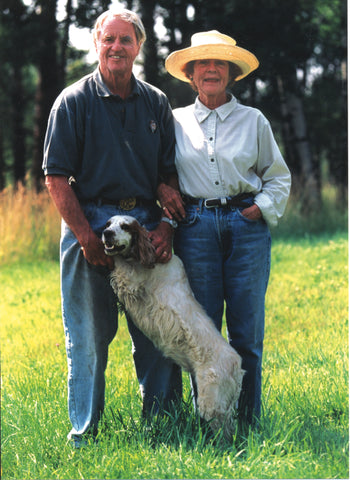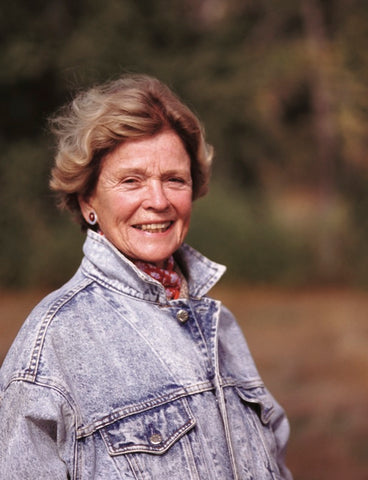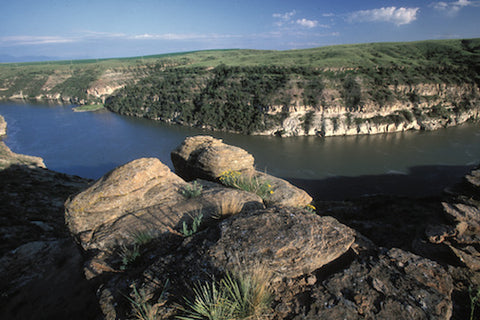KiKu Hanes: A Modern Day Sacajawea
Conservationists at heart
By Darren Guyaz/for Montana Living — Sept. 9, 1805. Meriwether Lewis and William Clark, along with a cadre of men from the Corps of Discovery, stop at the confluence of the Bitterroot River and Lolo Creek southwest of Missoula.
Their Lemhi Shoshone guide, Old Toby, instructs them to rest here in preparation for the long arduous journey over the Bitterroot Mountains. Taking his advice, they set up camp, hunt and rest.
For centuries, Native American tribes had camped here because of its abundant wildlife, refreshing mountain stream and plenty of firewood. Lewis and Clark heed his recommendation and stay for two days, before they continue their westward push toward the pacific coast.
Nearly two centuries have passed since the Corps of Discovery Expedition came through this place and now KiKu Hanes pauses beneath cottonwoods turning amber with September's chill. 
Kiku and Johnnie Hanes
She stops along the banks of Lolo Creek, turns and glances at leaves spiraling down from a gentle breeze, an easterly wind blowing in from the Bitterroot Mountains. Morning fog begins to dissipate as warm sun pierces through, lighting up the palette of autumn and KiKu's locks of white hair. Hanes, a Montanan and one of the founding members of the Conservation Fund, is the driving force behind preserving sites along the Lewis and Clark National Historic Trail. Here at the recently created Traveler's Rest State Park in Lolo, she sees her vision becoming a reality.
"It's been a while since I've been here," she says, gazing at distant clouds lifting from Lolo Peak and the stands of larch dotting the mountain's slopes with gold amidst coniferous green. "It's so beautiful, isn't is?" Traveler's Rest State Park is one of many sites along the Lewis and Clark trail that stretches from Missouri to Fort Clatsop on the Oregon coast.
This newly acquired site has become one of the latest projects spearheaded by Hanes and the Conservation Fund, an organization that began operating in 1985 under the direction of Patrick Noonan, Hanes and a handful of others. In conjunction with its partners, the Conservation Fund has since helped protect more than 4 million acres of wildlife habitat, watersheds, community open-space, historical sites and working land. Long before she began her work in the field of conservation, Hanes fostered a passion for wanderlust.

"My father was in the Foreign Service, so even though I grew up in New York, I traveled all over the world," Hanes recalls. When she moved to Washington D.C., a friend of hers had mentioned the Nature Conservancy. She got a job with them as a fund-raiser. At that time the Fund was the only conservation organization that used the concept of a revolving fund.
Hanes explains how this works: Money from donors goes into the revolving fund, which is invested in land purchases. As public and private funds become available and repay revolving fund dollars, the money is then re-invested in new acquisitions, thereby continuing to accumulate and expand purchasing power. Hanes and Noonan, after helping to bring the Nature Conservancy out of the red, decided to start an organization of their own.
Their brainchild - the Conservation Fund - would be very small, very entrepreneurial, and without memberships. "We wanted to approach conservation in a businesslike way," Hanes says. "We have been very successful. We are very collaborative. By working in partnerships and following the demands of the public, we get a lot done." Just in Montana, the Conservation Fund has helped to preserve over 18,000 acres, with more than 27 miles of river frontage protected and 10 additional miles under agreement. Crimson Bluff near Townsend, Sulphur Springs below Great Falls, Devil's Elbow east of Helena, and now Traveler's Rest in Lolo are areas protected under the Lewis and Clark Initiative, a project that brought Hanes to Bozeman in the mid-1990s. Her assignment was to open a regional field office and begin working to preserve sites along the Lewis and Clark trail.
Missoula resident Bruce Bugbee and others provided networking and essential support for Hanes when she first arrived. Today, her network continues to grow stronger as Hanes continues to reach out to those around her. It takes a special skill and a certain person to do this. "I've made wonderful friends doing this work," Hanes says nonchalantly. "And it's hard to be a good friend and a fund-raiser. But it's all about teamwork. You have to have teamwork; you have to have partnerships; you have to work together." Partnerships are many.

The Conservation Fund works with many individuals, corporations and public agencies to accomplish their work. Sally Lyons-Brown has been a key contributor of funds, giving more than $700,000 to the Fund. Senator Conrad Burns of Montana, has also been extremely supportive on a political level.
Jenna Thompson, a spokesperson at the Conservation Fund's headquarters in Arlington, Virginia, says Burns has been instrumental in helping. Burns is chairman of the Interior Appropriations Subcommittee, which provides money to many public land management agencies. He plays a large role in appropriating funds and, according to Hanes, is especially fond of the Lewis and Clark Initiative. Quick action has also been necessary in preserving the historic stopping points along the trail.
Rapid development in Montana during the 1990s threatened Lewis and Clark sites like Traveler's Rest. Open space, once taken for granted in Montana, has become increasingly endangered. A small portion of land remained at Crimson Bluff to be developed into 25-acre ranchettes.
Hanes and company stepped in and were able to preserve the last two remaining parcels. Traveler's Rest, threatened by rapid growth in nearby Missoula, is another significant accomplishment. More than 50 acres of creek-side acreage, open fields and cottonwood stands are now preserved. "I have a passion for open space - I think it's wonderful and exciting," Hanes smiles and glances out the window, where a couple of hundred yards and a couple hundred years away, Lewis and Clark rested their weary feet.
"You come out here and the space is overwhelming. There's no better place to come than Montana." Though Hanes now lives thousands of miles away from the Fund's main office, Thompson reiterates that she continues to be an inspiration to women throughout the Fund, herself included.
Hanes blushes when Bugbee, sitting next to her, compares her to a modern-day Sacajawea, leading the way for the Fund, guiding the organization through periods of great challenges and obstacles.
"It requires thinking about the art of the possible," Hanes responds. "I just do what I love to do. I love the challenges. I love the people I work with - they are so full of energy and it rubs off on you. If you care enough about something and follow it, you'll be successful."
- Darren Guyaz is a Missoula-based writer.




Leave a comment